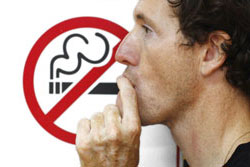Introduction
Adopting healthy behaviours and avoiding unhealthy behaviours is the key measure an individual can take to prevent chronic illness such as obesity, diabetes and cancer. On average individuals with healthy behaviours, for example those who eat well, do not smoke and get plenty of exercise, live longer than those who do not adopt healthy behaviours.
Significant events, like the beginning of the New Year, can provide additional motivation for adopting healthy behaviours. At this time people commonly make resolutions about goals they wish to achieve in the New Year, and these goals are often health related. For example, people often resolve to lose weight, to quit smoking or to get more exercise in the New Year.
The New Year is a time of good intention. However, despite good intentions, many individuals fail to fulfil their New Year’s resolutions, because changing health related behaviours is complex and often challenging. New Year’s resolutions often become unstuck before the end of January. Planning and receiving support and advice to change health related behaviours are important measures which will help you to stick to your New Year’s resolutions.
Health professionals, including your GP, can provide advice and support to help you change unhealthy behaviours in the New Year. They may also refer you to other health professionals, for example to a nutritionist for dietary advice or a psychologist for cognitive behavioural therapy. Bear in mind that many health behaviours, and therefore resolutions to change them, are inter-related. For example, you may smoke to avoid weight gain or to deal with stress. Health professionals can also provide advice to ensure improvements in one area of your health (e.g. quitting smoking) do not lead to other aspects of your health deteriorating (e.g. weight gain). For example, if you are quitting smoking and want to avoid weight gain, a health professional could help you plan strategies to avoid increasing your energy intake. Therefore, exercise might be suggested in place of smoking as it is a great way to avoid weight gain and to reduce stress.
New Year’s health resolutions
Sticking to a quit smoking resolution

If you have decided to quit smoking in the New Year, it’s important to talk to your GP or another health professional and find out about the support and assistance they can offer while you try to quit smoking. You are probably already aware of the dangers of smoking, but your doctor may be able to provide information about the benefits of quitting smoking (e.g. that the risk of coronary heart disease halves within a year and the overall risk of dying for an ex-smoker 15 years after quitting is the same as for a non-smoker) to increase your motivation.
 |
For more advice on how to quit smoking in the New Year, see New Year’s Resolution: Quit Smoking and How to Quit Smoking. |
Losing weight and keeping it off

The only way to lose weight and keep it off is to develop healthy eating patterns that provide a foundation for good nutrition and healthy weight in the long term. It is important to develop weight loss strategies for the New Year which consider both energy intake and expenditure. Restricting calorie intake so that there is a negative energy balance (more energy is expended through physical activity than consumed in the diet) is the only way to lose weight, but it’s not simply about eating less. Eating a wide variety of fresh, healthy food while avoiding energy dense foods and beverages like alcohol, soft drinks, chips and sweets, is the best strategy. It will reduce calorie intake in the short term, but you will still be able to eat a large variety of foods. You’ll also be developing healthy eating patterns which will reduce the likelihood that the weight you lose will be regained in the future.
If you’re planning to lose weight in the New Year, it’s also a good idea to monitor your energy intake and expenditure throughout the holidays so that you do not gain more weight before your New Year’s resolution begins.
 |
For more information about obesity, including statistics, and weight loss strategies, see Obesity and Weight Loss. |
Being active, everyday
Being active is also an important weight loss strategy as the more active an individual is, the more energy they burn. 30 minutes of moderate physical activity each day is the minimum amount recommended for healthy living. It’s a fairly modest amount of exercise, but the World Health Organisation report that as much as 60% of the world’s population fail to achieve these levels. To lose a significant amount of weight you will probably need to increase your physical activity levels more substantially. Aim for 80 minutes of moderate physical activity every day.
Start with simple lifestyle changes such as walking instead of driving and taking the stairs instead of the lift. Increase your physical activity levels from there, by incorporating 30 minute walks and other low-impact exercises like swimming into your daily routine. Over time you should aim to continuously and gradually increase the intensity, duration and frequency of the physical activity you perform.
If you are overweight or have not exercised for a long time, it may be necessary discuss your exercise plan with a specialist to avoid injury. However, most people can plan their own exercise regime, bearing in mind that the exercise programs most likely to be sustained are those that fit into your existing lifestyle.
 |
For more information about how your body uses the energy you consume, see Energy Expenditure: How the Body Burns Calories. |
In addition to improving fitness levels and assisting with weight loss, physical activity has other health benefits. It’s an important component of maintaining cardiovascular health. Weight bearing exercise (including walking) improves bone mineral density. Performing physical activity is also associated with improved quality of life, and other positive psychological effects. Exercise reduces levels of stress and anxiety, increases self-esteem and provides an opportunity for developing social skills.
Tips to help achieve New Year’s resolutions

- Set goals early to prepare for the New Year: After the season of festive over-indulgence, getting back into healthy lifestyle patterns can be difficult. Defining goals in advance helps. December is a good time to write down specific goals which are realistic. Unrealistic expectations can lead to loss of motivation when they are not achieved. Goals should be specific and include details of the behaviours which you will change. For example, if you want to lose weight the goal you write down may include details of physical activity you will perform (e.g. walking to work every morning and, if rain prevents that, walking home in the afternoon) and dietary changes (e.g. eat a low-calorie breakfast every day, keep unhealthy food out of the weekly shopping). Specify time frames in which these goals can realistically be achieved;
- Prepare in the festive season: Including maintaining physical activity levels, avoiding weight gain and cutting down on the number of cigarettes smoked in the festive season, will make it easier for you to achieve your resolutions in the New Year. Exercise in the New Year will be harder for you if you spent your entire holiday lazing on the beach or in front of the television. Avoiding weight gain while you’re on holiday means you’ll have less weight to lose in the New Year. If you have not exercised for some time it might be a good idea to take a fitness test and do some preparatory exercise before the New Year begins;
- Share your resolutions: With friends, family members and other loved ones so that those around you know about your goals and can support you to achieve them in the New Year;
- Learn about the health benefits change: And the potential health risks which may present in the absence of behaviour change. Make sure you get evidence-based health information from your doctor and think about how the information relates to your life. This will help you clarify the reasons why you want to change. It’s a good idea to write your reasons down so you can refer to them in the future, perhaps at times when achieving your New Year’s resolution seem a little too challenging;
- Develop strategies to prevent relapse of old behaviours: Changing health-related behaviours is not easy and you are likely to face challenges along the way, for example financial reasons may make it difficult to eat healthy food or time constraints may make exercising daily a challenge. Identifying ways to overcome these challenges in advance is important. You may even lapse into old behaviours at times. It’s important not to give up on your New Year’s resolution if you occasionally slip up. For example, if you are quitting smoking and smoke a cigarette, you should see it as a slip up, not complete failure, and continue with your quit attempt;
- Have a positive attitude to healthy change: Feel positive about your New Year’s resolutions and the steps you will be taking to achieve the desired outcomes. It may be necessary to identify barriers which prevent you from developing a positive attitude to healthy behaviour, for example loved ones who do not see weight loss or exercise as important or positive behaviours.
References
- National Institute of Clinical Excellence. Behaviour change at population, community and individual levels. 2007. [cited 3 December 2011]. Available from: [URL Link]
- University of Maryland Medical Centre. New Year’s Resolutions Guide. 2010. [cited 3 December 2011. Available from: [URL Link]
- Australian Government Department of Health and Ageing. Smoking cessation guideline for general practice [online]. 2004 [cited 13 December 2011]. Available from: [URL Link]
- Ellerman A, Ford C, Stillman S. Smoking cessation: 7.7: Personal factors associated with quitting. In: Scollo M, Winstanley M (eds). Tobacco in Australia: Facts and Issues (3rd edition) [online]. Carlton, VIC: Cancer Council Victoria; 2008 [cited 13 December 2011]. Available from: [URL link]
- Ellerman A, Ford C, Stillman S. Smoking cessation: 7.17: Combined interventions. In: Scollo M, Winstanley M (eds). Tobacco in Australia: Facts and Issues (3rd edition) [online]. Carlton, VIC: Cancer Council Victoria; 2008 [cited 13 December 2011]. Available from: [URL link]
- Ellerman A, Ford C, Stillman S. Smoking cessation: 7.5: Intensity of intervention. In: Scollo M, Winstanley M (eds). Tobacco in Australia: Facts and Issues (3rd edition) [online]. Carlton, VIC: Cancer Council Victoria; 2008 [cited 13 December 2011]. Available from: [URL link]
- Clinical practice guidelines for the management of overweight and obesity in adults [online]. Canberra, ACT: Australian Government Department of Health and Ageing; 18 September 2003 [cited 13 December 2011]. Available from: [URL link]
- Proietto J, Baur L. Management of obesity. Med J Aust. 2004;180(9): 474-80. [Abstract | Full text]
- Panel on Macronutrients & Standing Committee for the Scientific Evaluation of Dietary Reference Intakes. Physical Activity. Chapter 12. Dietary Reference Intakes for Energy, Carbohydrate, Fibre, Fat, Fatty Acids, Cholesterol, Protein and Amino Acids (Macronutrients), National Academy of Sciences. 2005. [cited 13 December 2011], Available from: [URL Link]
- Chapter 5: Energy. In: Dietary Reference Intakes for Energy, Carbohydrate, Fibre, Fat, Fatty Acids, Cholesterol, Protein and Amino Acids (Macronutrients) [online]. Washington, DC: National Academy of Sciences; 2005 [cited 13 December 2011]. Available from: [URL link]
- Healthy weight: It’s not a diet, it’s a lifestyle! Getting started [online]. Atlanta, GA: Centres for Disease Control and Prevention; 27 January 2009 [cited 13 December 2011]. Available from: [URL link]
- Yanovski JA, Yanovski SZ, Sovik KN, et al. A prospective study of holiday weight gain. N Engl J Med. 2000;342(12):861-7. [Abstract | Full text]
- Suija K, Pechter U, Kalda R, Tahepold H, Maaroos J, Maroos HI. Physical activity of depressed patients and their motivation to exercise: Nordic Walking in family practice. Int J Rehab Res. 2009; 32: 132-8. [Abstract | Full Text]
- Hoffman J. Physiological Aspects of Sport Training and Endurance. New Jersey: Human Kinetics; 2002. [Book]
- National Institutes of Health- Osteoporosis and related bone diseases national resource centre. Exercise for your bone health. 2009, [cited 3 December 2011]. Available from: [URL Link]
- Brukner P, Khan K [eds]. Clinical Sports Medicine. 3rd ed. North Ryde: McGraw-Hill; 2010. [Book]
- Alexander SM, Baur LA, Burrel S, et al. How to Treat: Childhood and Adolescent Obesity. Aust Doc. 2011; July. [Full Text]
- von Hippel PT, Powell B, Downey DB, Rowland NJ. The effect of school on overweight in childhood: Gain in body mass index during the school year and during summer vacation. Am J Public Health. 2007;97(4):696-702. [Abstract | Full text]
- Cancer Council NSW. Quit tips [online]. 2009 [cited 13 December 2010]. Available from: [URL Link]
All content and media on the HealthEngine Blog is created and published online for informational purposes only. It is not intended to be a substitute for professional medical advice and should not be relied on as health or personal advice. Always seek the guidance of your doctor or other qualified health professional with any questions you may have regarding your health or a medical condition. Never disregard the advice of a medical professional, or delay in seeking it because of something you have read on this Website. If you think you may have a medical emergency, call your doctor, go to the nearest hospital emergency department, or call the emergency services immediately.







